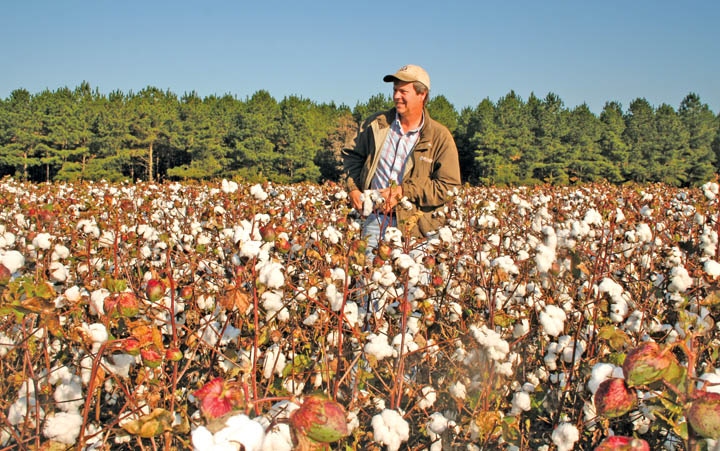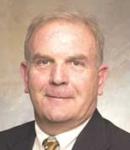
Starting from scratch brings big results for cotton farmer
Starting from scratch in the cotton business was a tough row to hoe for St. Matthews, S.C., grower Kendall W. (Kent) Wannamaker.But, today he and his wife, Mary Lil, own and operate a thriving cotton, peanut, and corn farming operation, and he is a recognized leader in the cotton industry.
January 5, 2012

Starting from scratch in the cotton business was a tough row to hoe for St. Matthews, S.C., grower Kendall W. (Kent) Wannamaker.
But, today he and his wife, Mary Lil, own and operate a thriving cotton, peanut, and corn farming operation, and he is a recognized leader in the cotton industry.
He also is president and co-owner of Farmers Gin Company LLC at St. Matthews, and is a partner in Carolina Peanut LLC, a peanut buying station at Cameron, S.C.
His accomplishments in cotton production, combined with his stewardship of resources and his leadership in the agricultural community, have earned him the Farm Press/Cotton Foundation High Cotton Award for the Southeast states.
Wannamaker, who grew up in a farming family and graduated from Clemson University with a degree in plant sciences, had planned to return after college and help run the family farming operation begun by his grandparents.
Which is what he did for five years.
Then, in the mid-1980s, his father and uncle decided to retire from farming and put their land in the Conservation Reserve Program, leaving Wannamaker with some life-altering choices to be made.
“It was a difficult decision for my father and my uncle to retire from farming,” he says, “ but at the time, the outlook was grim for the whole farming industry. Our farm had a lot of highly erodible land, and the CRP program looked like the best thing to do at the time.”
Thanks in large part to 30 acres of land given to him by his grandmother, Lucile Wannamaker, he was able to venture into the swine business.
“My grandmother was a legend in her time,” he says. “She had her own farming operation and she recognized early on that I wanted to be involved with farming. We’ve come a long way with our farming operation — but it all started on those 30 acres of land.
“Other than those 30 acres, I didn’t have any land, so in 1985 I began a small scale swine business. That’s about all I could fit on the land.”
Gradually increased numbers
Over the next 10 years, he gradually increased his farrow-to-finish operation to 500 sows, one of the state’s largest swine operations. When hog contracting became popular and there were fewer markets for independently raised hogs, Wannamaker realized it was time to diversify.
Row crop farming seemed the logical fit, but it was hard to find good farmland to rent in 1995. He had to forward pay land rent — something not commonly done in the area — just to convince landowners to take a chance on renting him their land.
After three years of farming 300 acres, one of the top growers in the area, J.D. (Pally) Wiles of Ft. Motte, S.C., was looking for someone to rent his land.
“Mr. Pally was willing to give me the opportunity to fulfill my dream of having enough land to justify buying the equipment I needed.”
Since then, Wannamaker has built his farming operation to about 3,000 acres. In most years he grows cotton (more than 1,000 acres annually), peanuts, and corn.
Prior to the end of the federal peanut program in 2002, there had been only a few thousand acres of peanuts grown in South Carolina. When the program ended, Wannamaker and three other farmers had the foresight to renovate an old, rundown soybean processing facility and start a peanut buying station at Cameron, S.C.
Getting into the peanut business in 2003 began a series of what some would consider risky business moves.
Two years later, Wannamaker and another group of farmers purchased a cotton gin, at a time when many wondered how much future cotton had in the Southeast. (Ironically, his family had owned and sold a cotton gin at St. Matthews, and the gin which he currently serves as president was the primary competitor for his family’s gin.)
“When we purchased the gin, it had been closed for four years,” he says. “People thought we were crazy, because there were five established gins in the area. At first we ginned our own cotton, and a very few customers. Over the last seven years, we have increased the business one grower at a time.”
In addition to the risks involved on the business side of cotton, he contends with the yearly risks of growing cotton.
“The improvement in varieties has probably been the biggest change in cotton production during my lifetime in cotton,” he says. “From a base of two or three varieties just a few years back, we now have many options that allow us to fit a specific variety to a specific piece of land.”
Wannamaker has been doing variety trials for Deltapine and provides feedback to the company as it evaluates new varieties to bring to the market each year. Last year, he did similar variety trials for Stoneville and Phytogen.
Good varietal comparison
“We do most of these tests in module plots, which allows us to take a certain acreage of land, weigh the cotton, gin it, and calculate final turnout. This gives us a better comparison of varieties than we would get in smaller plots or side-by-side tests.”
Another big change in the cotton business in recent years has been the development of on-board module pickers.
But while Wannamaker says, “We will probably always grow a lot of cotton,” he still wants the flexibility to change, if markets dictate it.
“The cost of the new pickers almost requires that you grow about 2,000 acres of cotton for it to pay, and I don’t want to be locked into growing 2,000 acres of cotton.”
The on-board module pickers would allow him to reduce his labor force, he says, but right now he is blessed with good labor. “I remember how hard it was when I first started farming, so I’m always looking to the younger generation to find people interested in farming. I have three young men working for me now, and they can do anything in our farming operation.
“With all the new technology we have available, farm operations can be much more precise. These young men grew up with computers and they’re comfortable with GPS-guided tractors and all the new technology. Having qualified people to put this equipment to good use is a blessing.”
He recalls that when he started growing peanuts in 2002, he suffered big harvest losses because he couldn’t see the rows to dig his crop. He invested in a RTK-guidance system and has subsequently bought a second system. Adapting GPS technology for use in cotton and grain production has made those operations run more smoothly, he says.
For the foreseeable future, Wannamaker says, cotton will likely be a big part of his farming operation.
“It appears much of the safety net cotton farmers have had in the past will be gone in the future — and that’s troubling,” he says. “Crop insurance is better than nothing, but it’s not all that farmers need to keep risks at a manageable level.”
In 2002, farmers in and around Calhoun County, S.C., suffered through a drought that nearly put him and others out of business. Since then, he has looked closely at crop insurance, and it has helped in some years.
Doesn’t cover costs
However, he says, recouping the maximum amount from a crop failure — typically 75 percent of crop value — only allows a farmer to keep farming; it doesn’t cover his costs.
Over the years, Wannamaker has developed a marketing strategy that helps him to reduce some of the risk in farming. For the past few years, he has subscribed to Pinnacle Marketing Service, which provides key marketing information that allows him do a limited amount of hedging of his crops. He forward contracts his cotton, or sells it on recaps after the crop is ginned, which has helped him get optimum prices.
Seven years ago, he switched to strip-tillage on all his cotton land and says the change has been amazing — dramatically increasing water infiltration and reducing water runoff and erosion.
“I used to need diversions and terraces,” he says, “but I don’t any more, unless we get 3-4 inches of rain at once. We have about 900 acres of irrigation, and even on that land, we can tell the difference from strip-tillage.”
From his earliest days in farming, Wannamaker has been a good steward of the land. He was named South Carolina Conservationist of the Year in 2004, and currently serves as a commissioner with the Calhoun County Soil and Water Conservation District.
In 2008, he was named South Carolina Farmer of the Year by Swisher International. He currently serves as an officer on the Southern Cotton Growers Inc. board and is a delegate to the National Cotton Council.
In giving back to his community, he has served for many years on the Calhoun County Clemson Extension Advisory Committee and on the administrative board of St. Paul United Methodist Church in St. Matthews.
He and Mary Lil have a daughter, Lindsey, who works with AFLAC insurance company in Columbia, S.C., and a son, Kendall, who is in his first year of medical school at the Medical University of South Carolina in Charleston.
“When I went out on my own in farming in 1985, it was a scary thing,” Wannamaker says. “I’ve been blessed to be surrounded by good friends and good people to help in the day-to-day operation of our farming business, and it has all worked out well.”
About the Author(s)
You May Also Like





